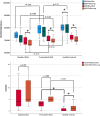Shedding light on motor premanifest myotonic dystrophy type 1: A molecular, muscular and central nervous system follow-up study
- PMID: 36256504
- PMCID: PMC10092190
- DOI: 10.1111/ene.15604
Shedding light on motor premanifest myotonic dystrophy type 1: A molecular, muscular and central nervous system follow-up study
Abstract
Background and purpose: Myotonic dystrophy type 1 (DM1) is a hereditary and multisystemic disease that is characterized by heterogeneous manifestations. Although muscular impairment is central to DM1, a premanifest DM1 form has been proposed for those characterized by the absence of muscle signs in precursory phases. Nevertheless, subtle signs and/or symptoms related to other systems, such as the central nervous system (CNS), may emerge and progress gradually. This study aimed to validate the premanifest DM1 concept and to characterize and track affected individuals from a CNS centred perspective.
Methods: Retrospective data of 120 participants (23 premanifest DM1, 25 manifest DM1 and 72 healthy controls) were analysed transversally and longitudinally (over 11.17 years). Compiled data included clinical, neuropsychological and neuroradiological (brain volume and white matter lesion, WML) measures taken at two time points.
Results: Manifest DM1 showed significantly more molecular affectation, worse performance on neuropsychological domains, lower grey and white matter volumes and a different pattern of WMLs than premanifest DM1. The latter was slightly different from healthy controls regarding brain volume and WMLs. Additionally, daytime sleepiness and molecular expansion size explained 50% of the variance of the muscular deterioration at follow-up in premanifest individuals.
Conclusions: Premanifest DM1 individuals showed subtle neuroradiological alterations, which suggests CNS involvement early in the disease. Based on follow-up data, a debate emerges around the existence of a 'non-muscular DM1' subtype and/or a premanifest phase, as a precursory stage to other DM1 manifestations.
Keywords: Steinert's disease; central nervous system; disease progression; follow-up; muscular onset; myotonic dystrophy type 1; premanifest.
© 2022 The Authors. European Journal of Neurology published by John Wiley & Sons Ltd on behalf of European Academy of Neurology.
Conflict of interest statement
All authors declare no conflict of interest regarding the content of this article.
Figures


References
-
- Harper PS. Myotonic dystrophy. 3rd ed. London, UK; 2001.
-
- Sistiaga A, Urreta I, Jodar M, et al. Cognitive/personality pattern and triplet expansion size in adult myotonic dystrophy type 1 (DM1): CTG repeats, cognition and personality in DM1. Psychol Med. 2010;40(3):487‐495. - PubMed
Publication types
MeSH terms
LinkOut - more resources
Full Text Sources

